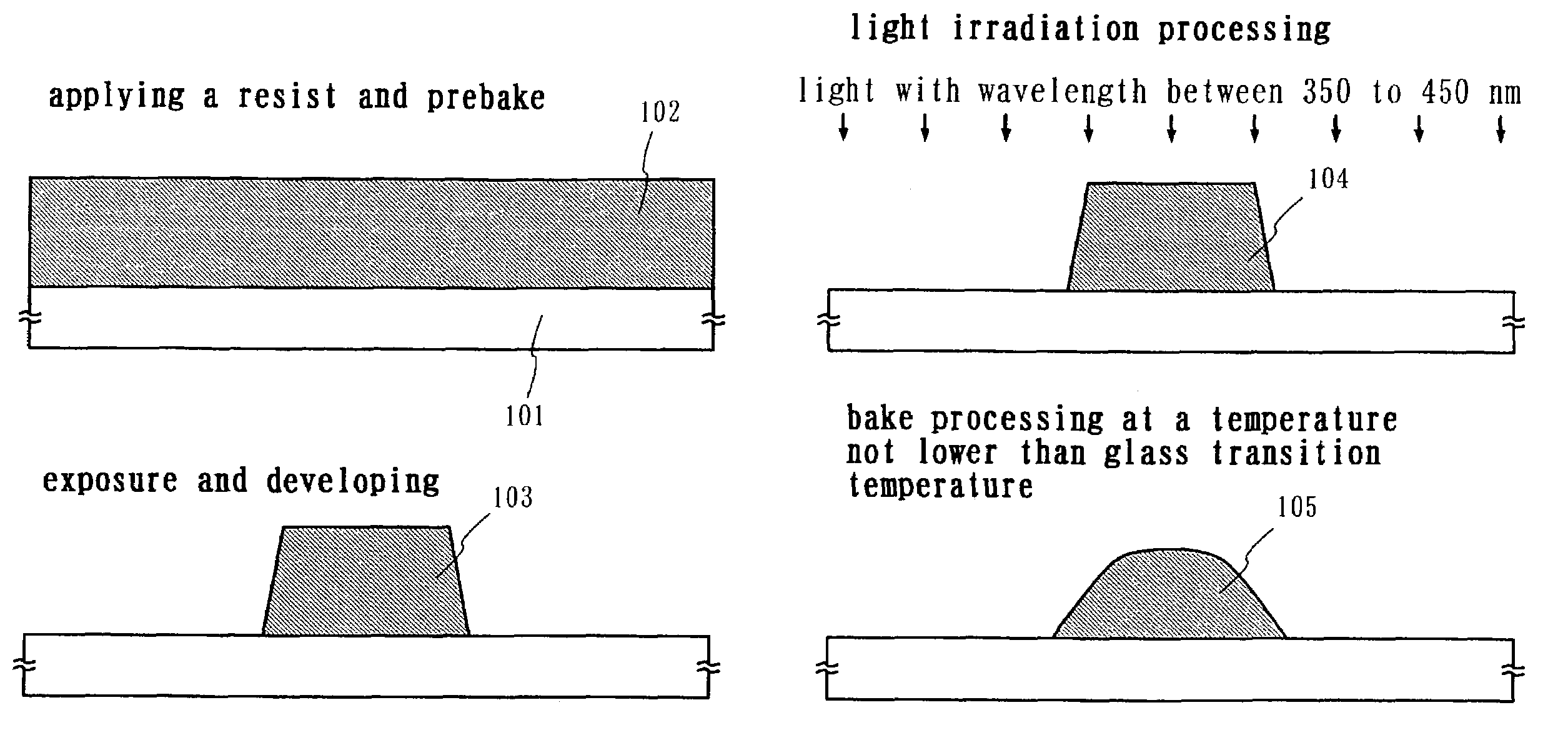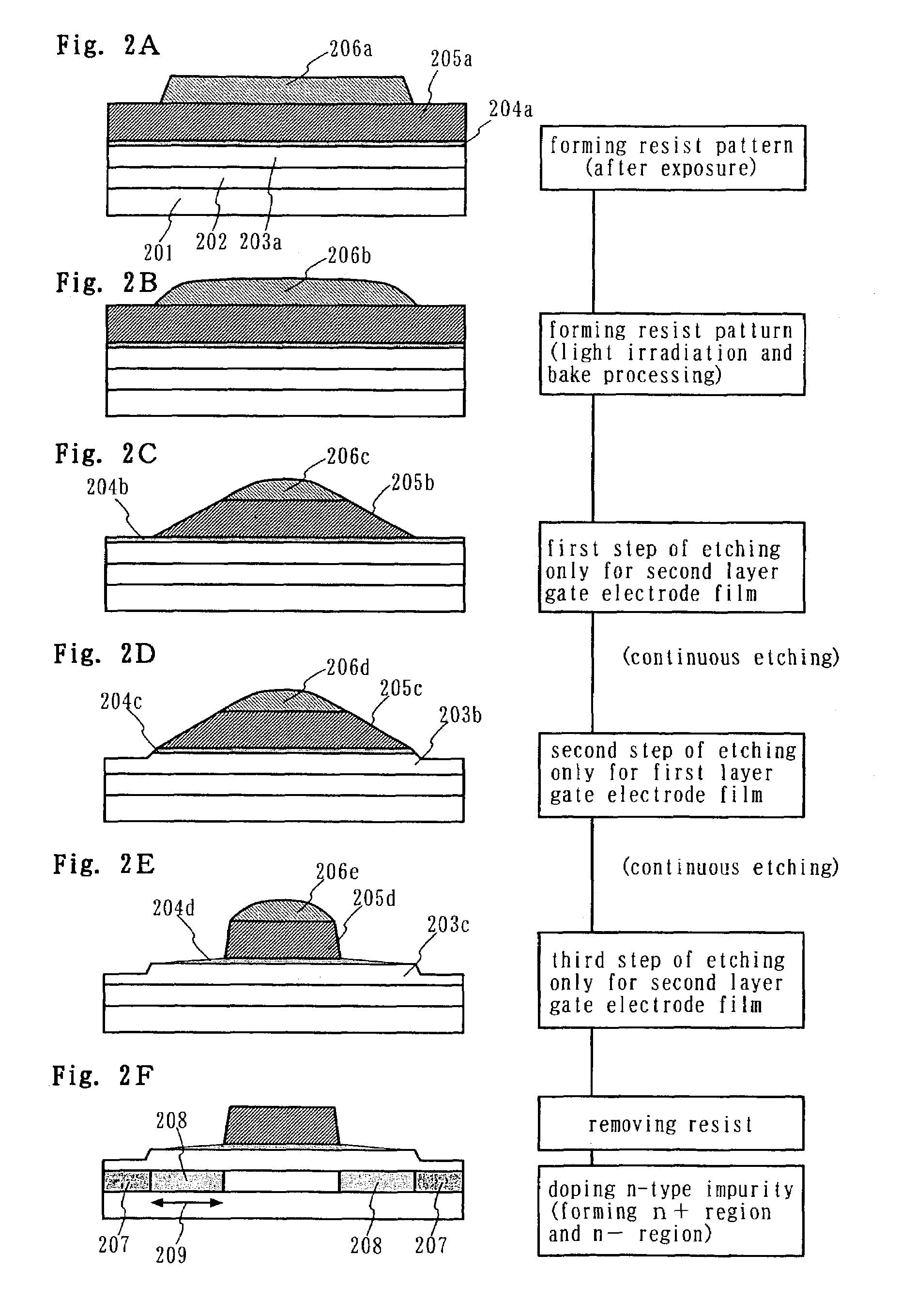Method of fabricating semiconductor device, and developing apparatus using the method
a technology of semiconductor devices and developing apparatus, which is applied in the direction of photomechanical equipment, instruments, photosensitive material processing, etc., can solve the problems of resist pattern sidewall angle becoming difficult to measure accurately, resist removal becoming difficult, and sidewall angle becoming rounded
- Summary
- Abstract
- Description
- Claims
- Application Information
AI Technical Summary
Benefits of technology
Problems solved by technology
Method used
Image
Examples
embodiment 1
[0057]A resist pattern forming method according to Embodiment 1 of the invention will be described below with reference to FIGS. 1A to 1D. FIGS. 1A to 1D are cross-sectional process diagrams showing the resist pattern forming method.
[0058]First, a DNQ-novolac resin type of positive resist which is generally applied to a semiconductor device fabricating process is formed with a predetermined film thickness on an insulating transparent glass substrate 101 by spin coating method. After that, a predetermined time of prebake processing at a processing temperature of approximately 100° C. is performed to evaporate the solvent contained in the formed resist film and form a stable resist film, thereby forming a resist film 102 of predetermined film thickness. At this time, since the film thickness of the resist film 102 influences the size of a resist pattern to be finally formed, the precise control of spin conditions for spin coating is needed (refer to FIG. 1A).
[0059]Then, a 1:1 projecti...
embodiment 2
[0063]In the following description of Embodiment 2, based on FIGS. 2A to 2F, reference will be made to the case where the resist pattern forming method according to the invention is applied to a gate electrode forming process which includes a GOLD-structure TFT fabricating process. Incidentally, FIGS. 2A to 2F are cross-sectional process diagrams showing the GOLD-structure TFT fabricating process.
[0064]First, the structure of a substrate used in Embodiment 2 will be described. The shown substrate includes a glass substrate 201 which is an electrically insulating transparent substrate, and a base film (not shown) comprising a silicon oxide nitride film having a film thickness of 150 nm is deposited over the glass substrate 201, and a semiconductor layer which is a TFT active layer comprising a polycrystalline silicon film 202 having a film thickness of 50 nm is formed over the base film. A gate insulating film 203a comprising a silicon oxide film having a film thickness of 100 nm, a ...
embodiment 3
[0076]In the following description of Embodiment 3, a developing apparatus capable of performing continuous processing on the resist pattern forming process according to the invention will be described with reference to FIGS. 3 to 4. FIG. 3 is a schematic plan view showing the whole of the developing apparatus, and FIGS. 4A and 4B are cross-sectional views showing a specific construction of a light irradiation unit which constitutes a feature of the invention.
[0077]FIG. 3 is a schematic plan view showing the whole of the developing apparatus capable of performing continuous processing on the resist pattern forming process according to the invention, and shows a substrate-by-substrate processing type of developing apparatus 301 capable of continuously processing substrates to be processed one-by-one. The developing apparatus 301 includes a loader-side carrier 303 capable of accommodating a plurality of substrates 302 to be processed (generally, approximately twenty substrates), a plu...
PUM
| Property | Measurement | Unit |
|---|---|---|
| photosensitive wavelengths | aaaaa | aaaaa |
| sidewall angle | aaaaa | aaaaa |
| temperature | aaaaa | aaaaa |
Abstract
Description
Claims
Application Information
 Login to View More
Login to View More - R&D
- Intellectual Property
- Life Sciences
- Materials
- Tech Scout
- Unparalleled Data Quality
- Higher Quality Content
- 60% Fewer Hallucinations
Browse by: Latest US Patents, China's latest patents, Technical Efficacy Thesaurus, Application Domain, Technology Topic, Popular Technical Reports.
© 2025 PatSnap. All rights reserved.Legal|Privacy policy|Modern Slavery Act Transparency Statement|Sitemap|About US| Contact US: help@patsnap.com



